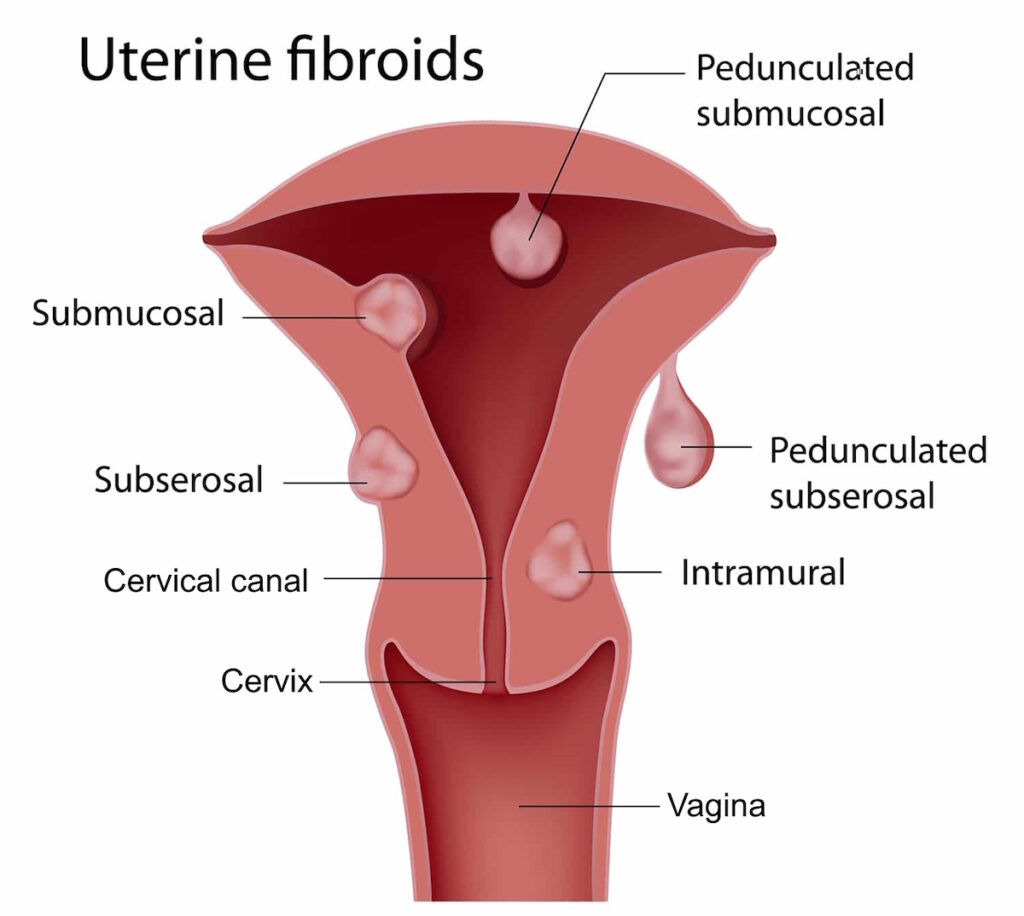While there is still so much to learn about fibroids and how to increase education and awareness efforts globally, it’s safe to say that more women than ever realize how common fibroids are. Researchers estimate that 70-80 percent of all women will experience fibroid symptoms in their lifetime. These benign tumors formed in the uterus muscle tissue can develop in different locations, differ in size, and either stay that way or grow at different rates.
Granted, not all women are aware they have fibroids or experience pain. Still, those who do could experience fibroid symptoms ranging from heavy bleeding to pelvic pain and pressure, weight gain, and irregular periods. What many women may not realize, however, is that while most women develop fibroids between 35 and 54, it is possible to start seeing them and their symptoms as early as your 20s. Understanding how they develop throughout your life and the evolution of potential symptoms can help you take control of your fibroid journey and future healthcare decisions.
Our team of fibroid experts at Fibroid Institute Texas wants all women to know that they don’t have to suffer in silence with fibroid symptoms or be caught off guard by the diagnosis, regardless of their age or degree of condition. Whether you’re just now experiencing symptoms or have struggled for years, we’re here to guide you every step of the way during treatment, offering expert care and compassionate solutions tailored to your needs.
A Decade-by-Decade Breakdown of Fibroid Symptoms
Fibroids are more common as women age—especially during their 30s and 40s through menopause. But that does not mean a younger female in her 20s won’t start developing them and experiencing symptoms. How is this possible in someone so young? Remember that fibroids are under hormonal control—specifically, estrogen and progesterone. Women experience their highest levels of these hormones during their reproductive years.
As a result, fibroids tend to grow more rapidly and potentially in greater numbers. In many cases, they can vary from the size of a pea or bean to a melon or grapefruit and cause pregnancy-looking swelling of the abdomen.
Here is a breakdown of what is considered a small or large fibroid.
- Small fibroids — Between 1 cm and 5 cm. Basically, the size of a small seed to a cherry.
- Medium fibroids — Between 5 cm to 10 cm. Can be the size of a plum to an orange.
- Large fibroids — Greater than 10 cm. The size of a melon, grapefruit, watermelon, or a small pumpkin.
As a result, fibroid symptoms can evolve over time and quickly become a condition that may span decades of your life without the proper awareness and treatment options.
Here is a closer look at how fibroid symptoms can impact women differently through their 20s, 30s, 40s, and 50s.
Uterine Fibroids in Your 20s

We must first say that while developing fibroids in your teens and early 20s is possible, it’s also extremely rare. According to one study, approximately 1.8% of women aged 20 to 29 were diagnosed with uterine fibroids. This is true even though women are in their reproductive years during this decade and are thinking about having children. Most women who do have fibroids in their 20s present smaller versions of these tumors. Thus, they are unaware they have them and often don’t find out unless during a routine pelvic exam.
Those without fibroid symptoms may consult with their OBGYN and decide to take a wait-and-see approach. Those with symptoms can experience varying degrees of discomfort depending on their unique situation. Some may see smaller changes in their menstrual cycle, pelvic pain and pressure, and mild pain during sex. That said, fibroids can grow rapidly and in clusters during this decade, thus leading to more pronounced symptoms.
Uterine Fibroids in Your 30s
Fibroids often become more noticeable during this decade. A woman will likely present larger fibroids and in greater clusters throughout her uterus. If you are diagnosed with fibroids, getting an MRI is the best way to reveal the size, location, and number of fibroids you may have. From there, you and your doctor can establish a treatment plan based on your personal and medical needs.
For instance, you may experience increased menstrual bleeding during this stage, which can lead to anemia. Many women in their 30s may have difficulties with getting pregnant or existing pregnancies due to fibroid location. Even if immediate treatment isn’t necessary, knowing the location of your fibroids may provide insight into your uterine fibroid symptoms and help you make more informed decisions.
If you are a young woman in your 30s and already have large fibroids, you may want to take care of them before they get bigger and more difficult to treat. After all, size and location do make a difference.
- Intramural fibroids: These grow inside the uterine wall muscles and are the most common fibroid type, affecting one in four women of childbearing age.
- Submucosal fibroids: These protrude underneath the uterine lining and into the uterine cavity, causing issues with uterine function while also causing heavy bleeding during menstruation and increased abdominal pain.
- Subserosal fibroids: Tend to grow just outside the uterine walls and can ultimately impact surrounding organs. As a result, they can put pressure on the bladder, bowels, and abdomen.
- Pedunculated fibroids: These uterine fibroids hang by a thin thread or stalk inside or outside the uterus. They are more likely to cause abdominal pain due to obstruction of the uterus and organs.

Uterine Fibroids in Your 40s
Many fibroid specialists would say this is the decade when fibroids are at their peak in terms of size, location, and symptoms. Granted, some women in their 40s may be asymptomatic or have symptoms that are mild or manageable. But for the most part, fibroid symptoms tend to become more severe and expansive.
Examples of symptoms you may experience during this stage include debilitating menstrual cramps, anemia due to excessive blood loss, back and leg pain, an enlarged abdomen, constipation, and prolonged periods. For many of these women, the discomfort can become so intense that the next step is immediate intervention. The number of options available to women is constantly increasing. Below is a list of options to consider:
- Medications — Medications primarily focus on managing symptoms like heavy menstrual bleeding and pain. Nonsteroidal anti-inflammatory drugs (NSAIDs) can help reduce pain, while oral contraceptives or progestins regulate menstrual cycles and lessen bleeding. These medications don’t shrink the fibroids but provide symptom relief.
- Hormone therapy — This treatment regulates the levels of hormones like estrogen and progesterone, which can shrink the fibroids or reduce their growth. Medications such as gonadotropin-releasing hormone (GnRH) agonists temporarily lower estrogen levels, causing fibroids to shrink and alleviating symptoms like heavy bleeding. However, hormone therapy is usually a temporary solution and doesn’t remove the fibroids entirely.
- Uterine Fibroid Embolization (UFE) — Provided by a specialized fibroid doctor known as an interventional radiologist, UFE is a minimally-invasive procedure that, rather than removing fibroids with numerous incisions, cuts off blood flow to all fibroids—causing them to shrink and die. UFE is safe, non-surgical, and offers a faster recovery time than fibroid surgery. It is low risk, does not require incisions, and can be completed in a fibroid clinic or office as opposed to requiring a costly hospital stay. For patient life quality, important benefits of undergoing UFE are relief from symptoms associated with fibroids, like heavy menstrual bleeding, depleted energy, and being homebound during your menstrual cycle.
- Acessa — A small probe is placed into a fibroid and heated. By heating the fibroid, it is ultimately destroyed. Acessa works even if you have several uterine fibroids. But there are limitations. If you have multiple large fibroids or fibroids that are hard to get to, Acessa is not a good choice. It is also not covered by some insurance companies.
- Endometrial Ablation — If you have no interest in getting pregnant in the future, ablation can remove fibroids from the inside lining of the uterus. Doctors place a thin instrument into the uterus through the cervix and use heat, laser, electricity, microwaves, or freezing. It will not treat fibroids outside the interior uterine lining.
- MR-Guided Ultrasound (MRgFUS) — With this procedure, a high-intensity ultrasound beam, guided by MRI, is focused on the fibroid tissue to heat and break it down. Some MRgFUS systems have scar tissue and patient weight restrictions. Downsides may include potential for skin burns, numbness, temporary back or shoulder pain, and although rare, nerve damage or blood clots.
- Sonata System —Using an intrauterine ultrasound device, radiofrequency energy is delivered to the fibroid to shrink the fibroid. This incision-less fibroid treatment works well when the patient has one or several fibroids. However, it is not recommended for all fibroids. Sonata works well when the patient has one or several fibroids and/or non-pedunculated submucosal fibroids. Fibroids larger than 5.0 cm may require multiple ablations.
- Hysterectomy — A hysterectomy is a surgical procedure that removes all or part of a woman’s uterus. In some cases, her fallopian tubes and ovaries are removed, too.
- Myomectomy —Another surgical procedure, a myomectomy preserves the uterus while removing the fibroids. As a result, it often recommended for women who want to get pregnant.

Uterine Fibroids in Your 50s
Because your body is producing fewer hormones during menopause, this causes your fibroids to shrink and eventually die. Therefore, when it comes to menopause and fibroids, many clinicians believe fibroids shrink when a woman goes through menopause since this is a period during which hormone levels are lower. That said, it is important to note that menopause and fibroids affect each woman differently, and menopause is not a guaranteed cure for fibroids. In addition, women taking hormone replacement therapy (HRT) during perimenopause or after menopause may not see symptoms decrease. This is because HRT usually contains a combination of estrogen and progesterone. These are the same hormones that allow fibroids to grow in younger women.
No Matter Your Stage of Life and Fibroid Journey, Fibroid Institute Is Here To Help
Fibroids are most common in women between 35 and 54. But that doesn’t mean you won’t experience fibroids or fibroid symptoms earlier in life. Since every woman is different, and factors such as age, hormones, and genetics are always at play, fibroids can quickly become a life-long concern. That said, women need not worry about their future. Fibroid symptoms are uncomfortable, but the fibroids themselves are usually harmless. They can be treated in various ways, whether through surgery or less invasive treatment options such as UFE.
When the time is right, and the correct treatment option presents itself, your doctor and our team of fibroid experts are ready to take that next step with you. At Fibroid Institute, we do not believe you need to decide between suffering in silence and having invasive surgery. We are dedicated to treating fibroids using Uterine Fibroid Embolization (UFE), the gold standard in non-surgical fibroid treatment.
When UFE is performed by our team, patients experience a high success rate with minimal discomfort.
- Procedure typically completed in under an hour
- In-office procedure instead of hospital stay
- Recovery time is usually 1 week
- Tiny wrist puncture, no need for vaginal access
- Avoid side effects of pharmaceutical hormone therapies
- All fibroids may be treated at the same time
- No incisions, which means no surgical scarring
- Over 90% of patients see dramatic improvement in symptoms
Very few practices across the country are dedicated 100% to fibroid treatment. That is where Fibroid Institute Texas makes its mark. The concierge model at Fibroid Institute means patients get personalized and complete care from the initial consultation through post-procedure follow-ups. UFE patients can access their fibroid doctor’s mobile number to call or text with questions and concerns.

Most major medical insurance providers cover the cost of UFE. Request a free 10-15 minute phone screening to determine if you are eligible. After the screening, if you qualify for UFE, you can schedule your onsite or telehealth consultation. With multiple locations, our Dallas and Houston fibroid clinics help thousands of women avoid fibroid surgery and find relief from their fibroid symptoms.
Get started now in Dallas by calling 214-838-6440, in Houston by calling 713-903-3733, or complete the form below. We are dedicated to helping you become #FibroidFree.
Fibroid Institute Texas serves the Dallas and Houston metro areas including Richardson, Dallas, Sherman, Houston, Sugar Land, Katy, Webster, Clear Lake, The Woodlands, Universal City, Spring, Kingwood, Stafford, Conroe, Texas City, Cypress, League City, Bellaire, Addison, Carrollton, Plano, Frisco, Craig Ranch, McKinney, Allen, Fort Worth, Grand Prairie, Hurst, Euless, Bedford, Arlington, Hutchins, Irving, Duncanville, DeSoto, Cedar Hill, Lancaster, Cockrell Hill, Highland Park, University Park, Park Cities, Garland, Mesquite, and more.
This information is not a substitute for professional medical advice. Prior to starting any new treatment or if you have questions regarding a medical condition, always seek the advice of your doctor or other qualified health provider.
*Patient names and/or photos may be changed to protect patient confidentiality.

